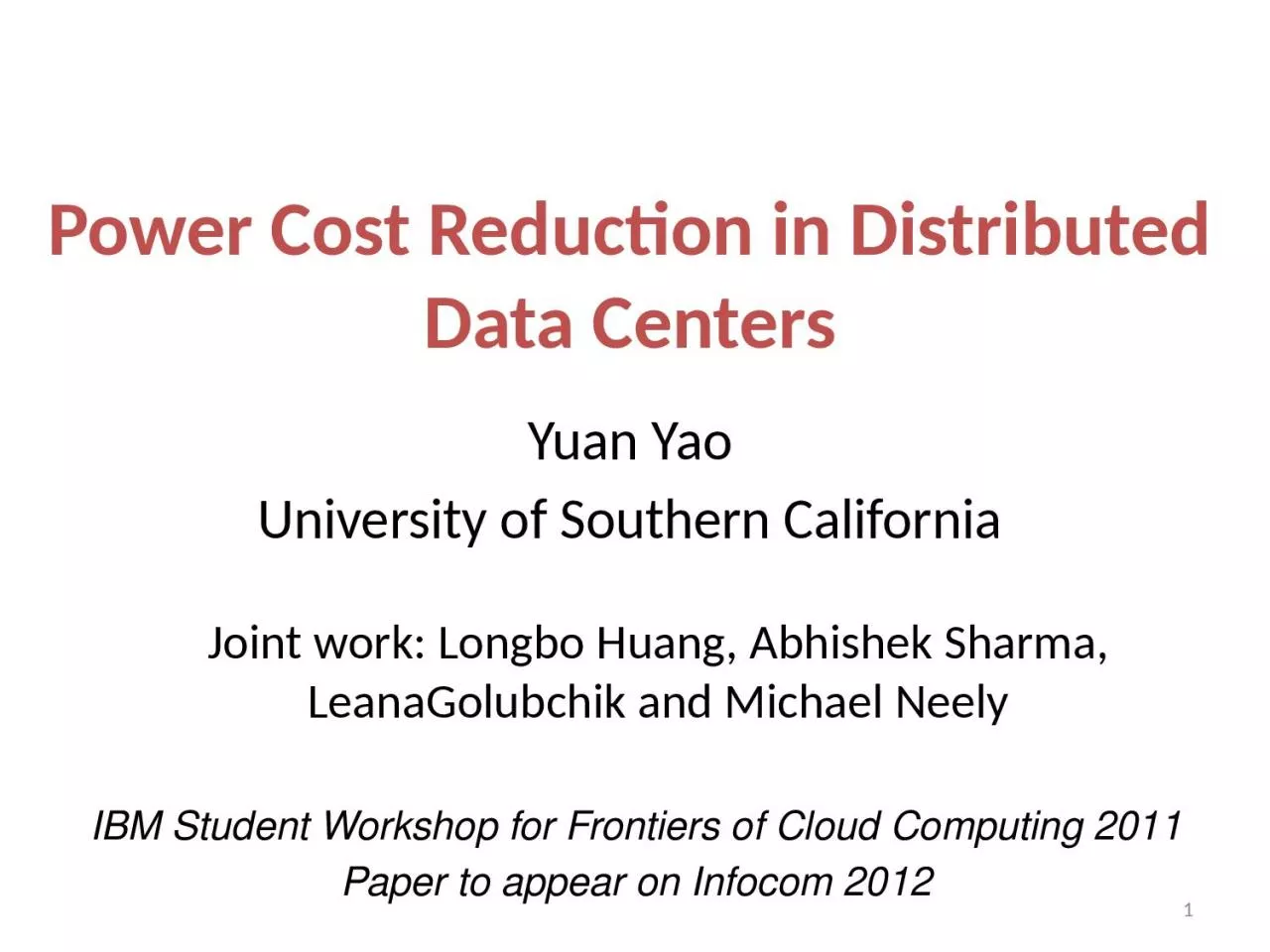

Yuan Yao University of Southern California 1 Joint work Longbo Huang Abhishek Sharma LeanaGolubchik and Michael Neely IBM Student Workshop for Frontiers of Cloud Computing 2011 Paper to appear on ID: 1002523
Download Presentation The PPT/PDF document "Power Cost Reduction in Distributed Data..." is the property of its rightful owner. Permission is granted to download and print the materials on this web site for personal, non-commercial use only, and to display it on your personal computer provided you do not modify the materials and that you retain all copyright notices contained in the materials. By downloading content from our website, you accept the terms of this agreement.
1. Power Cost Reduction in Distributed Data CentersYuan YaoUniversity of Southern California1Joint work: Longbo Huang, Abhishek Sharma, LeanaGolubchik and Michael NeelyIBM Student Workshop for Frontiers of Cloud Computing 2011Paper to appear on Infocom 2012
2. Background and motivationData centers are growing in number and size…Number of servers: Google (~1M)Data centers built in multiple locationsIBM owns and operates hundreds of data centers worldwide…and in power cost!Google spends ~$100M/year on powerReduce cost on power while considering QoS2
3. Existing ApproachesPower efficient hardware designSystem design/Resource managementUse existing infrastructureExploit options in routing and resource management of data center3
4. Existing ApproachesPower cost reduction through algorithm designServer level: power-speed scaling [Wierman09]Data center level: rightsizing [Gandhi10, Lin11]Inter data center level: Geographical load balancing [Qureshi09, Liu11]4$5/kwh$2/kwhjob
5. Our Approach: SAVEWe provide a framework that allows us to exploit options in all these levels+ Temporal volatility of power prices =StochAstic power redUctionschEme(SAVE)5Server levelData center level Inter data center levelJob arrived Job served
6. Our Model: data center and workloadM geographically distributed data centersEach data center contain a front end server and a back end clusterWorkloads Ai(t) (i.i.d) arrive at front end servers and are routed to one of the back end clusters6µji(t)
7. Our Model: server operation and cost 7Back end cluster of data center i contain Ni serversNi(t) servers activeService rate of active servers: bi (t) ∈[0, bmax]Power price at data center i: pi(t) (i.i.d) Powerusage at data center i:Power cost at data center i:
8. Our Model: two time scaleThe system we model is two time scaleAt t=kT, change the number of active servers Nj(t)At all time slots, change service rate bj(t)8
9. Our Model: summaryInput: power prices pi(t), job arrival Ai(t)Two time Scale Control Action: Queue evolution:Objective: Minimize the time average power costsubject to all constraints on Π, and queue stability9
10. SAVE: intuitionsSAVE operates at both front end and back endFront end routing:When , choose μij(t)>0Back end server management:Choose small Nj(t) and bj(t) to reduce the power costfj(t) When is large, choose large Nj(t) and bj(t) to stabilize the queue 10
11. SAVE: how it worksFront end routing: In all time slot t, choose μij(t) maximizeBack end server management: Choose V>0At time slot t=kT, choose Nj(t) to minimizeIn all time slots τ choose bj(τ) to minimizeServe jobs and update queue sizes 11
12. SAVE: performanceTheorem on performance of our approach:Delay of SAVE ≤ O(V)Power cost of SAVE ≤ Power cost of OPTIMAL + O(1/V)OPTIMAL can be any scheme that stabilizes the queues 12V controls the trade-off between average queue size (delay) and average power cost.SAVE suited for delay tolerant workloads
13. Experimental SetupWe simulate data centers at 7 locationsReal world power pricesPossion arrivalsWe use synthetic workloads that mimics MapReduce jobsPower Cost13Power consumption of active serversPower usage effectivenessPower consumption of servers in sleepPower price
14. Experimental Setup: Heuristics for comparisonLocal Computation Send jobs to local back endLoad BalancingEvenly split jobs to all back endsLow Price (similar to [Qureshi09])Send more jobs to places with low power pricesAll servers are activated 14Instant On/OffRouting is the same as Load BalancingData center i tune Ni(t) and bi(t) every time slot to minimize its power costNo additional cost on activating/putting to sleep serversUnrealistic
15. Experimental ResultsAs V increases, power cost reduction grows from ~0.1% to ~18%SAVE is more effective for delay tolerant workloads.relative power cost reduction as compared to Local Computation15
16. Experimental Results: Power UsageOur approach saves power usage16We record the actual power usage (not cost) of all schemes in our experiments
17. SummaryWe propose atwo time scale, non work conserving control algorithm aimed atreducing power costin distributed data centers.Our work facilitating an explicit power cost vs. delay trade-offWe derive analytical bounds on the time average power cost and service delay achieved by our algorithm Through simulations we show that our approach can reduce the power cost by as much as 18%, and our approach reduces power usage.17
18. Future workOther problems on power reduction in data centersScheduling algorithms to save powerDelay sensitive workloadsVirtualized environment, when migration is available18
19. Questions?Please check out our paper:"Data Centers Power Reduction: A two Time Scale Approach for Delay Tolerant Workloads” to appear on Infocom 2012Contact info:yuanyao@usc.eduhttp://www-scf.usc.edu/~yuanyao/19